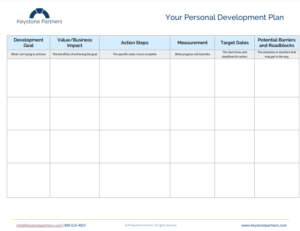
According to research from Gallup on employee retention and attraction, workplace culture and engagement factors significantly outweigh compensation in employees’ decisions to leave organizations. The data reveals that “Engagement and Culture” (37%) combined with “Wellbeing and Work-Life Balance” (31%) account for 68% of the reasons employees left their employers in 2024—four times more than those who left primarily for better pay or benefits. Organizations that focus on creating growth opportunities and meaningful work are more likely to retain their talent and attract new employees.
Recognizing that career advancement opportunities are among the top factors that attract employees to different organizations, both employees and managers are increasingly turning to Personal Development Plans (PDPs) as a strategic tool to align individual aspirations with organizational objectives. When employees can explore what Gallup identifies as important attraction factors—such as “opportunity to do what I do best” and “greater work-life balance”—and match these with organizational needs, both sides benefit. When these discussions result in documented steps and action plans, organizations create the kind of employee value proposition that Gallup’s research shows is essential for effective retention strategies.
1. What is a PDP and Why Do You Need One?
2. The Relationship Between PDPs and Performance Reviews
3. Practical Tips for Creating Effective Personal Development Goals
4. Create Your Own PDP
What is a Personal Development Plan and Why Do You Need One?
Personal Development Plans outline an individual’s goals, aspirations, and actionable steps for continuous personal and professional improvement. These plans are dynamic, evolving with changes in an individual’s career, skills, and organizational needs. PDPs serve as roadmaps, guiding employees through their professional journey by providing a clear vision of where they want to go and how they plan to get there.
A well-structured PDP helps individuals identify areas for growth, set meaningful personal development goals, and create actionable strategies to achieve them. Whether you’re looking to advance in your current role, transition to a new career path, or enhance specific competencies, a PDP provides the framework needed for focused and consistent progress.
Key Components of a Personal Development Plan
An effective PDP includes several critical components:
- Goals and Objectives: Delineate your long-term vision, establish short-term and long-term objectives, and define specific, measurable, achievable, relevant, and time-bound (SMART) goals.
- Skills and Competencies Assessment: Identify current skills and competencies and those needed for future roles or responsibilities. Develop plans to acquire new skills through training, mentorship, or hands-on experiences.
- Learning and Development Activities: Outline specific activities such as training programs, workshops, conferences, and courses that contribute to skill enhancement. Include both technical and soft skills development.
- Timeline and Milestones: Establish a realistic timeline for achieving each goal and milestone. Break down larger objectives into manageable tasks with associated deadlines.
- Support and Resources: Define the support needed and by whom. Clarify how managers will support the plan and what other people need to contribute.
- Feedback and Evaluation: Define a process for obtaining feedback from peers, mentors, and managers. Regularly evaluate progress and adjust the plan as needed.

The Relationship Between Personal Development Plans and Performance Reviews
Performance reviews provide feedback useful to individuals in assessing their skills, contribution, employee brand and strengths. However, an increasing number of companies separate Personal Development Plans and discussions from the Performance Review process. The intention for those firms is that PDPs provide a structured and forward-looking approach to individual growth and should be focused on future development, motivation, and what matters to the employee.
Separating development discussions from evaluation can allow for more open conversation. When an employee is new or not performing up to speed, then the performance evaluation informs a more immediate term PDP. In either scenario – whether the discussion is part of the performance review or separate – aligning personal development objectives with organizational goals contributes not only to the professional development of employees but also to the overall success of the organization.
How PDPs Enhance the Performance Review Process
Using PDPs in conjunction with performance reviews offers several benefits:
Focused Discussions
Prior development planning conversations allow both employees and managers to assess areas where job crafting could improve motivation and performance. It also improves their ability to focus on specific strengths and achievements to capitalize on going forward.
Alignment with Organizational Goals
Integrating personal development goals into the performance review process helps employees see the impact of their work on the organization’s objectives, a key factor in engagement.
Skill Gap Identification
Performance feedback can identify gaps in skills and competencies required for current and future roles. This information is invaluable for crafting targeted development plans that address specific needs.
Continuous Improvement
By integrating personal development discussions, organizations foster a culture of continuous improvement, setting the expectation that even high performers should continue to develop.
Learn more about conducting effective career conversations here >>
Practical Tips for Creating Effective Personal Development Goals
Creating personal development goals that drive meaningful growth requires thoughtful planning and self-reflection. Whether you’re an employee crafting your own plan or a manager supporting your team members’ development, these practical strategies can help ensure personal development plans translate into tangible career advancement and skill enhancement.
A successful personal development strategy balances aspiration with practicality, creating a roadmap that inspires continuous learning while remaining achievable. The following tips can help individuals at any career stage develop a personal action plan that leads to sustained professional growth.
Tips for Employees
- Conduct a Self-Assessment: Reflect on your strengths, weaknesses, and areas for improvement. Consider questions like: What aspects of your work energize you? What skills would you like to use more? What do you want to achieve in the next 2-3 years?
- Set SMART Goals: Ensure your personal development objectives are Specific, Measurable, Achievable, Relevant, and Time-bound. Break down larger goals into smaller, manageable tasks to facilitate progress tracking.
- Embrace Continuous Learning: Identify relevant training programs, workshops, and conferences to enhance your skills. Adopt a growth mindset and seek opportunities for cross-functional training.
- Build Your Network and Seek Mentorship: Develop a professional network within and beyond your organization. Seek guidance from mentors who can offer valuable insights based on their experiences.
Tips for Managers
- Encourage Open Communication: Create an environment where employees feel comfortable discussing their career goals and development needs. Conduct regular check-ins beyond annual reviews.
- Provide Resources: Allocate resources, such as time, budget, and training programs to support employees’ development initiatives.
- Recognize Progress: Acknowledge achievements and milestones reached through PDPs. Implement a system for recognizing employees who actively engage in their development.
- Create Cross-Functional Opportunities: Encourage employees to take on projects outside their immediate roles to gain new skills and perspectives.
Personal Development Plans emerge as essential tools for individual and organizational success. By fostering a culture of continuous improvement and aligning personal goals with overarching objectives, companies not only empower their employees to thrive, but also position themselves for sustained growth and innovation.
Whether you’re creating a self-development plan for your own career advancement or supporting your team’s growth as a manager, the structured approach offered by PDPs provides a clear pathway to achieving meaningful professional goals. Investing in personal development is an investment in the future, where both individuals and organizations can flourish in tandem. As the saying goes, “The only person you are destined to become is the person you decide to be.”
